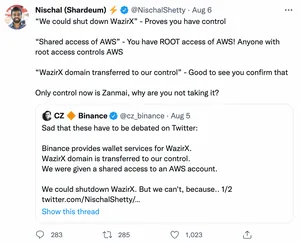Despite a 2019 blog post by Binance titled, "Binance Acquires India's Leading Digital Asset Platform WazirX to Launch Multiple Fiat-to-Crypto Gateways", Binance CEO Changpeng Zhao ("CZ") tweeted that "Binance does not own any equity in Zanmai Labs, the entity operating WazirX", and that besides wallet services and an off-chain transaction integration, "WazirX is responsible all other aspects of the WazirX exchange". These statements were disputed by Nischal Shetty, the founder of WazirX, who stated in no uncertain terms that WazirX was acquired by Binance. "Binance owns WazirX domain name. Binance has root access of AWS servers. Binance has all the Crypto assets. Binance has all the Crypto profits", Shetty wrote on Twitter.
No one wants to admit to owning the WazirX crypto exchange
Brand new Dragoma "move-to-earn" game rug pulls for around $3.5 million
The project launched only days before it rug pulled. On August 7, the $DMA token dropped in price over 99% as funds were removed from the project and moved to exchanges. According to CoinDesk, around $3.5 million was taken. The project's website, Telegram channel, and Twitter accounts were all taken offline.
Someone makes NFTs out of photographs from the Xinjiang Victims Database
Someone apparently decided this was perfect material for an NFT project, which they named "Made In Uyghur". They took 100 images from the database, clumsily projected them onto 3D-rendered human models in a T-pose, and listed them for $25 apiece.
Upon becoming aware of the NFTs, the Xinjiang Victims Database updated their site licensing to CC BY-NC, a Creative Commons license that forbids commercial reuse. "Commercial use of the data, including images of victims, is not okay", they wrote on Twitter, "[Made In Uyghur] never contacted us about this".
"Saxon James Musk" token developer rug pulls for around $442,000
The project developer suddenly sold off their share of the coin for around 1355 WBNB (~$442,000), sending the coin price plummeting by more than 68% as a result.
Beanstalk Farms comes back for round two after $182 million exploit
Now, Beanstalk is re-launching, saying they've made changes to their governance model and security practices, and have received audits from two major firms.
In June, the project creator stated that "The thing about a system like Beanstalk is that it works until it doesn't. You can never actually know if it works, only that it has worked so far."
Hacker compromises wallet of Steven Galanis, CEO of Cameo app, stealing $231,000
Galanis wrote on Twitter that he "Just got my Apple ID hacked". Although he didn't offer more details on how he had determined iCloud was to blame, it's likely he's referring to an attack vector where MetaMask automatically backs up users' seed phrases to iCloud unless it's disabled, meaning that a hacker who successfully accesses a person's iCloud account can also compromise any of their MetaMask wallets. The same type of attack saw a user lose $650,000 in April, and brought wider attention to the app's behavior.
Researchers identify an attack strategy actively being used by the second-largest Ethereum mining pool to earn outsized mining rewards
By manipulating the timestamps of blocks to be added to the chain, a miner can replace other miners' main-chain blocks with their own blocks, obtaining the fees that would have gone to the other miners. The attack has been called an "Uncle Maker" attack because Ethereum refers to valid but not main-chain blocks as "uncles".
F2Pool co-founder Chun Wang responded on August 8 to the allegations against his mining pool, apparently acknowledging their behavior and suggesting that manipulating a vulnerability in a system is not a "blatant disregard [of] the rules" as the researchers had characterized it. He tweeted: "We respect the *consensus* as is. If you don't like the consensus, convince [Ethereum developer Tim Beiko] to send me another Announcement and change it." Quote-tweeting a tweet by the lead author of the paper who described F2Pool's technique, he wrote, "I can't stop appreciate this elegant implementation of what we've done over the past two years... A robust system must withstand all kind of tests."
India freezes assets of WazirX, Binance's Indian exchange
The ED wrote in a press release, " ED found that large amounts of funds were diverted by the fintech companies to purchase crypto assets and then launder them abroad...(a) maximum amount of funds were diverted to WazirX exchange and the crypto assets so purchases have been diverted to unknown foreign wallets".
Ian Macalinao revealed to have pumped the total value locked on the Solana ecosystem by pretending to be 11 developers working on over a dozen projects
In an unpublished blog post where he confessed to his deception, he wrote, "I believe it contributed to the dramatic rise of SOL". He wrote the post shortly after one of his persona's projects, Cashio, was hacked for $52 million, but apparently shelved it.
Ian Macalinao's brother Dylan, the other co-founder of Saber protocol, aided in the scheme by lending credibility to Ian's various personas to those who had doubts about trusting money to projects led by pseudonymous individuals.
All told, Ian Macalinao was responsible for the Saber protocol, the Protagonist VC firm and incubator, and Ubeswap under his real name. He created Sunny Aggregator as Surya Khosla, Cashio as 0xGhostchain, Goki as Goki Rajesh, Quarry as Larry Jarry, TribecaDAO as Swaglioni, Crate as kiwipepper, aSOL as 0xAurelion, Arrow as oliver_code, Traction.Market as 0xIsaacNewton, Sencha as jjmatcha, and VenkoApp as ayyakovenko.
CoinGape and Binance publicize scam recovery address after Nomad hack
However, that was not the address that CoinGape published in their article titled "Breaking: Nomad Announces ENS Address And Bounty For Returning Funds" article, which was syndicated to Binance's news feed. Instead, they indicated that people should send funds to a different address, a scammer who had been sending on-chain messages to various people who took money out of Nomad during the exploit, asking they return it.
Although CoinGape removed the article fairly quickly, it remained live on Binance's site for over an hour. Fortunately, it doesn't appear anyone besides the writers have fallen for the scam, as no cryptocurrency has been sent to the address.








